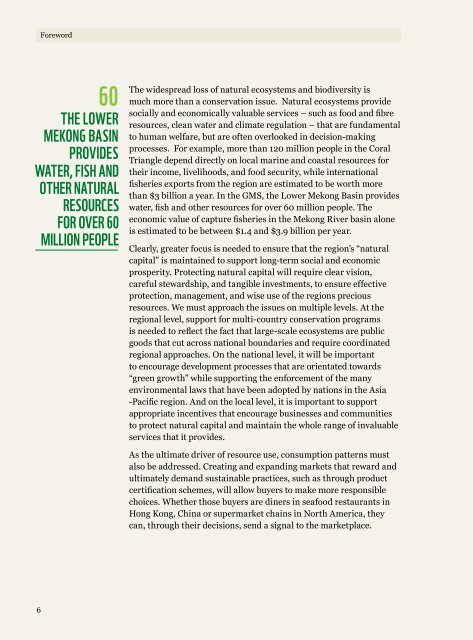Download the pdf - Global Footprint Network
Download the pdf - Global Footprint Network
Download the pdf - Global Footprint Network
You also want an ePaper? Increase the reach of your titles
YUMPU automatically turns print PDFs into web optimized ePapers that Google loves.
6<br />
Foreword<br />
60<br />
<strong>the</strong> LoWeR<br />
Mekong BAsIn<br />
PRovIDes<br />
WAteR, FIsh AnD<br />
o<strong>the</strong>R nAtuRAL<br />
ResouRCes<br />
FoR oveR 60<br />
MILLIon PeoPLe<br />
The widespread loss of natural ecosystems and biodiversity is<br />
much more than a conservation issue. Natural ecosystems provide<br />
socially and economically valuable services – such as food and fibre<br />
resources, clean water and climate regulation – that are fundamental<br />
to human welfare, but are often overlooked in decision-making<br />
processes. For example, more than 120 million people in <strong>the</strong> Coral<br />
Triangle depend directly on local marine and coastal resources for<br />
<strong>the</strong>ir income, livelihoods, and food security, while international<br />
fisheries exports from <strong>the</strong> region are estimated to be worth more<br />
than $3 billion a year. In <strong>the</strong> GMS, <strong>the</strong> Lower Mekong Basin provides<br />
water, fish and o<strong>the</strong>r resources for over 60 million people. The<br />
economic value of capture fisheries in <strong>the</strong> Mekong River basin alone<br />
is estimated to be between $1.4 and $3.9 billion per year.<br />
Clearly, greater focus is needed to ensure that <strong>the</strong> region’s “natural<br />
capital” is maintained to support long-term social and economic<br />
prosperity. Protecting natural capital will require clear vision,<br />
careful stewardship, and tangible investments, to ensure effective<br />
protection, management, and wise use of <strong>the</strong> regions precious<br />
resources. We must approach <strong>the</strong> issues on multiple levels. At <strong>the</strong><br />
regional level, support for multi-country conservation programs<br />
is needed to reflect <strong>the</strong> fact that large-scale ecosystems are public<br />
goods that cut across national boundaries and require coordinated<br />
regional approaches. On <strong>the</strong> national level, it will be important<br />
to encourage development processes that are orientated towards<br />
“green growth” while supporting <strong>the</strong> enforcement of <strong>the</strong> many<br />
environmental laws that have been adopted by nations in <strong>the</strong> Asia<br />
-Pacific region. And on <strong>the</strong> local level, it is important to support<br />
appropriate incentives that encourage businesses and communities<br />
to protect natural capital and maintain <strong>the</strong> whole range of invaluable<br />
services that it provides.<br />
As <strong>the</strong> ultimate driver of resource use, consumption patterns must<br />
also be addressed. Creating and expanding markets that reward and<br />
ultimately demand sustainable practices, such as through product<br />
certification schemes, will allow buyers to make more responsible<br />
choices. Whe<strong>the</strong>r those buyers are diners in seafood restaurants in<br />
Hong Kong, China or supermarket chains in North America, <strong>the</strong>y<br />
can, through <strong>the</strong>ir decisions, send a signal to <strong>the</strong> marketplace.

















